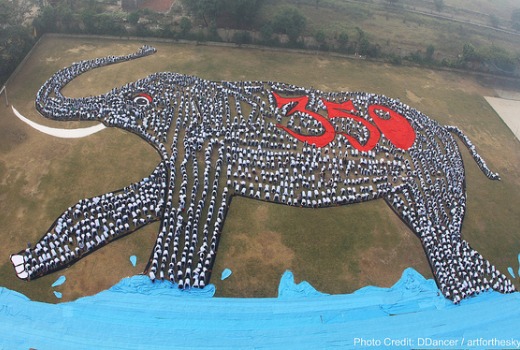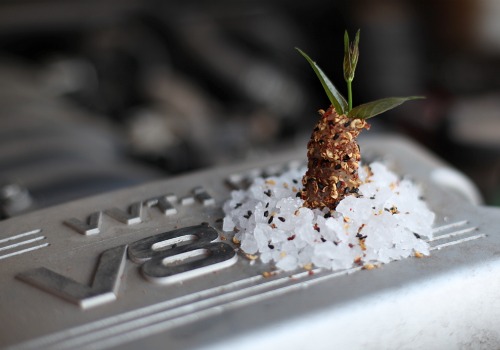See related slideshowThroughout history, artists have joined forces with political movements to battle injustice and demand a better and more beautiful world. Picasso’s “Guernica” captured the horrors of the German bombing of civilians in 1937. “Solidarity Forever,” “We Shall Overcome,” and “Give Peace a Chance” expressed the optimism and power of the labor, civil rights, and peace movements. Delacroix’s “Liberty Leading the People” embodied the utopian fervor of the French Revolution. Shepard Fairey’s Obama “Hope” silkscreen during the 2008 election captured America’s yearning for a more visionary politics.
Great upheavals demand great art. And now humanity faces the gravest of threats: climate change. The climate clock ticks ominously onward, but thus far we have been unable to marshal what Bill McKibben and Naomi Klein describe as the “bodies, passion, and creativity” required to avert impending economic and environmental disaster.
But passion comes from the heart, not the head, and climate activists have largely been targeting people’s upper organ, pleading their case with statistics, policy platforms, and poll-driven messaging. Maybe it’s time to aim lower. McKibben, the founder of 350.org, is one of the few climate activists thinking seriously about the relationship between art, activism and social change. He views artists as “antibodies of the cultural bloodstream” and key to social movement vitality:
[Artists] sense trouble early, and rally to isolate and expose and defeat it, to bring to bear the human power for love and beauty and meaning against the worst results of carelessness and greed and stupidity. So when art both of great worth, and in great quantities, begins to cluster around an issue, it means that civilization has identified it finally as a threat. Artists and scientists perform this function most reliably; politicians are a lagging indicator.
In its finest moments, art reveals our shared experience of pain and struggle, letting us know we are not alone. As Theodore Dreiser observed in 1917, “Art is the stored honey of the human soul, gathered on wings of misery and travail.” It has the ability to transform politics from a dry to a celebratory affair, using tools of laughter, sexuality, and beauty to coax people to cultural events where they experience, often for the first time, the power of social solidarity and political awakening. Art can help us digest and make sense of what is happening in our world — a process essential for spurring political action.
Deployed carefully, art can also provide a potent way to persuade troubled peoples that another world is possible. It appeals to our better nature, reminding us that love and joy are more powerful than hatred and violence. During times of upheaval, it appeals to our hearts, replaces fear with hope and determination, encouraging us to seek out new visionary ways to organize society.
 In this 350 EARTH installation, 3,000 people in New Delhi formed an enormous elephant threatened by rising seas — a plea to world leaders not to ignore the “elephant in the room.” Credit: Daniel DancerBut our activist culture has largely forgotten how to fight political battles with cultural tools. At protest after protest, we haul out the same exhausted puppets, chants, and songs. Our slogans and imagery are flat, prescriptive, and literal rather than poetic and inspirational. Compare the “Green Jobs Now!” placards at climate rallies to the iconic “I Am a Man” signs of the 1968 Memphis sanitation strike. One demands policy action; the other beautifully evokes hundreds of years of struggle for racial equality and justice.
In this 350 EARTH installation, 3,000 people in New Delhi formed an enormous elephant threatened by rising seas — a plea to world leaders not to ignore the “elephant in the room.” Credit: Daniel DancerBut our activist culture has largely forgotten how to fight political battles with cultural tools. At protest after protest, we haul out the same exhausted puppets, chants, and songs. Our slogans and imagery are flat, prescriptive, and literal rather than poetic and inspirational. Compare the “Green Jobs Now!” placards at climate rallies to the iconic “I Am a Man” signs of the 1968 Memphis sanitation strike. One demands policy action; the other beautifully evokes hundreds of years of struggle for racial equality and justice.
Sectors of the climate movement are trying to cure our cultural amnesia. 350.org has begun actively promoting and supporting climate change art, even retaining an official artist-in-residence on staff to coordinate climate art projects. Land artists around the world — who in the ’60s and ’70s sculpted landscapes to protest the artificiality and commercialization of art — have become prominent “messengers” of the climate movement, organizing massive land art projects in dozens of counties to communicate 350.org’s goals in Copenhagen and Cancun.
Other artists have begun to respond. There are now songs like “Melting Ice” by 10-year-old Lil Peppi, the “King of Eco-Rap”; or Jill Sobule’s satirical “Happy Song About Global Warming.” Using live collaborative online tools, art students in Colombia and Canada have produced a powerful stop-action video based on their personal reflections about the climate crisis:
At the same time, there is a new generation of artists who represent a revival of the arts and crafts movement of the early 20th century, but with a modern twist. In the face of the great upheavals of globalization and climate change, as well as the hyper-commercialization of the conceptual “high arts,” this “green arts movement” dedicates itself to creating art that is sustainable, handcrafted, and produced locally.
Rejected by much of the commercial art world, these artists sell their work at farmers’ markets, in abandoned city lots, and increasingly on DIY online venues like Etsy.com. They are less interested in the traditional art forms of painting, sculpture, and the like, and instead are creating a new form of political art that embeds the ethic of sustainability into every object they create. Obsessed with function, these artists are hell-bent on proving that building a localized, sustainable economy and culture is not just necessary, but possible. While others use imagery, metaphor, and rhyme to raise awareness about the climate crisis, these new green artists are living proof that we can build a more just and beautiful world.
This new generation includes artists like the Haitian designer Catherine Charlot, who handmakes dresses sewn from recycled umbrellas; Canadian designer Nolan Herbut, who uses discarded computer keyboards for his lighting designs; and New York artist Stephen Shaheen, who recently constructed a park bench out of 5,000 discarded MetroCards. Mike Thompson’s “Blood Lamp,” which is powered by a single drop of human blood, represents the dynamic outer fringes of the eco-friendly avant-garde:
Green artists are even setting up their studios in kitchens around the country. Our organization, the CultureWorks Collective, recently nominated sushi chef Bun Lai as our “Artist of the Month” because he embodies this new zeitgeist of sustainability. Lai’s dishes swirl with environmental awareness, economic justice, and mouth-watering sensation. He describes one dish, called Kiribati Sashimi, this way:
Kiribati Sashimi incorporates Kiribati sea salt. I use Szechuan pepper corns in my recipe, which creates an alternately hot and cold mouth sensation. I created it to raise awareness about global warming. At only eight to twelve feet above sea level, Kiribati may become the first nation to be engulfed by the ocean due to climate change. It is also one of the world’s poorest countries and is barely an afterthought in most people’s minds. I know my sea salt purchase is hardly an economic stimulus package for Kiribati but I am hoping that the awareness that my menu creates may be worth something in some unforeseen tangential way.
 Bun Lai’s “Kiribati Sashimi.”Photo: Jean Paul VellottiThis new, dynamic generation of green artists see themselves as much more than a community of artists. They envision themselves as members of a growing public sphere and cultural economy supporting those who grow or make what they sell. They represent a generation of organic farmers, green designers, activist musicians, and others who have fully merged their lives, their activism, and their art into one identity.
Bun Lai’s “Kiribati Sashimi.”Photo: Jean Paul VellottiThis new, dynamic generation of green artists see themselves as much more than a community of artists. They envision themselves as members of a growing public sphere and cultural economy supporting those who grow or make what they sell. They represent a generation of organic farmers, green designers, activist musicians, and others who have fully merged their lives, their activism, and their art into one identity.
If the climate movement is serious about crafting new organizing strategies around passion and creativity, we need to provide artists with resources and weave their work into our organizing strategies — rather than simply assigning them bit parts at political rallies. We need artists as movement strategists and tacticians. We need to seek out the new generation of green artisans and merge their culture of sustainability with the climate movement’s energy and militant activism.
At the same time, much of the arts industry remains oblivious to the climate crisis, let alone its civic duty to act. Humanity faces an existential threat while music and film producers dump billions into projects of little or no social value. Gallery and museum owners continue to view art through the narrow lens of conceptualism, marked by its rejection of craftmanship, aesthetics, and social use. In the face of mounting threats — ranging from worsening droughts and the northward march of climate-linked diseases to climbing food prices and rising seas — it’s time for the arts industry to do some serious soul-searching about whether it wants to sit this crisis out.
Let’s face it: As the world burns, the climate movement struggles to make its case. Climate legislation is dead in the Congress; global agreements seem less likely with each passing day. In 2008, 66 percent of Americans viewed climate change as a major threat; by March 2011, only 51 percent of the public was concerned. Millions of promised climate-reducing green jobs have not materialized.
We are mired in dark and cynical times, and left yearning for a ray of hope and vision. Artists see the world in a different light, a light we need now more than ever.
So we call on our fellow artists to join the climate movement and our fellow climate activists to embrace activist art. For, as the Bible says (Proverbs 29:18), “Where there is no vision, the people perish” — and so does the planet.
—–
To learn more about the green arts movement, read the “Green Art Minifesto.”
Also check out “Art in a changing climate,” a Grist special series.
